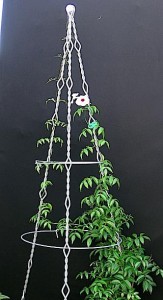Growing Beans in GreenSmart Pots
Tall Tales from Jack & the Beanstalk
Growing beans epitomises why I love gardening. At this time of the year I always look forward to being able to pick and eat beans from our garden throughout the summer months. Garden fresh beans are so much tastier than soggy super market beans. There are two types of summer beans to grow in GreenSmart Pots….. Dwarf beans and climbing beans.
Conditions for growing beans
Beans thrive in a warm, sunny spot out of the wind. They are nitrogen-fixers. ie they extract nitrogen from the air and store it on nodules on the roots so making nitrogen available for kick starting the next crop you plant in the same potting mix.
In most parts of New Zealand they can be planted from October to February. Ground temperatures should be above 15 deg C. Be sure to include plenty of good organic fertiliser mixed into the potting mix as the beans are going to need a lot of nutrients.
I prefer growing beans from seeds rather than transplanting plants because they do better without the disruption of transplanting. After preparing a large pot with organic fertilisers, plant 18 to 24 seeds at a depth of three cm or roughly three times the seed diameter. Stretch the elasticized plastic cover over the pot and wait 7 to 10 days until they have emerged into their own little hothouse. After removing the cover, you can enjoy watching the plants take off. In cooler parts of the country it is a good idea to position the GreenSmart Pot in a sunny spot then later shift it to its final position. Be on the lookout for slugs and snails when the seedlings are very young. Don’t let those slimy gastropods have a gastronomic feast at your expense!
Growing beans do best with shade on the roots and plenty of sun on the foliage.
Dwarf Beans
We enjoy these McGregor’s Gourmet Range dwarf beans called Borlotti Red Rooster. The mature beans are a wonderful cream and cranberry colour.
http://www.mcgregors.co.nz/seeds/gourmet-seeds/mcgregors-bean-borlotti-red-rooster

If you make a second sowing of dwarf beans in another six weeks you will have a longer period of continuous picking. Alternatively you can plant half a pot with beans and half with say cucumbers or lettuce or peas.
Climbing Beans
Several weeks ago we planted perennial Scarlet Runner climbing beans in the hothouse. Now they are well above my head and we are getting a meal every few days.
Here are some ideas for supporting climbing beans in GreenSmart Pots:
- Check out our amazing selection of very attractive and long life climbing frames at http://TRIPOD OPEN TEE PEE EXTRA LARGE
-
- Drive stakes into the ground at the four corners of the pot and use string tied between the stakes as a frame work for the beans to hang onto.
- Use bamboo stakes and build a four legged tee-pee above the pot for the runners to climb up.
- If the beans are on a deck of an apartment, use lengths of twine looped under the pot and tied overhead onto the overhead frame of the deck. Then train the beans up the twine.
- Erect a section of trellis alongside the pot.
Climbing beans produce beans over a longer period than dwarf beans. I nip off the growing tips when the plants reach about two metres high to encourage them to put more energy into producing bean pods rather than climbing higher.
Perennial beans will die back in autumn and then the plants will grow again in spring.
Fertilisers
Liquid fertiliser can be added into the water via the sight glass. I use liquid sea-weed and comfrey tea. The best time is while the plants are flowering. If you are getting a lot of leaf growth but not so many bean pods, it may be due to over fertilising.
Companion Plants
Beans like to be near Carrots, Cucumbers, Cabbages, Corn, Lettuce, Peas, Parsley, Cauliflower, Spinach and Summer Savory. Have you heard about the three sisters? Traditional Native American planting included growing beans, corn and pumpkins together. Try planting a pumpkin in the middle of the pot surrounded by climbing beans and corn. The corn provides a structure for the beans to climb up. The beans fix nitrogen into the soil for the other plants.
Avoid planting beans near onions, garlic, chives.
Harvesting
Dwarf beans and climbing beans will be ready for picking in 8- 12 weeks. Begin picking when the pods are about 10 cm long. Pods are ready if they snap easily when bent. Frequent picking encourages more flowers to continue developing.
Seed Saving
Saving your own bean seeds is easy. Choose a few of the best pods and allow them to fully ripen and dry. The seeds will swell up and the pod will develop a tough outer skin. Pick the beans, let them dry out in a sunny dry place for a week or two. Then pop out the seeds and store them in a jar or envelope for next year.
There is still time to grow all your own veges this summer. The self watering process in the GreenSmart pots will enable you to plant now, go away for holidays and your plants will keep growing.
It is good to grow with GrowGood


There are no comments